618th Medical Clearing Company Unit History
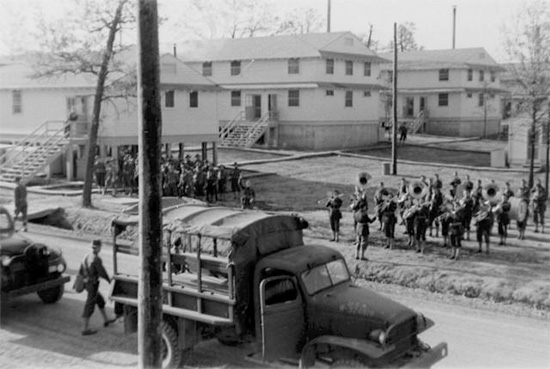
Camp Forrest, Tullahoma, Tennessee. Partial view of the installations. Camp Forrest was not only a Training Center for Infantry, Artillery, Engineer and Signal organizations, but also a Hospital Center. During Second US Army Maneuvers, Camp Forrest became temporary Quartermaster and Ordnance depots and the principal railhead. It was also frequently used as a bivouac area for troops during Maneuvers. This is the station where the 618th Medical Clearig Company was activated.
Introduction and Activation:
The 618th Medical Clearing Company was originally constituted as the 53d Hospital Company (part of the Regular Army) in March 1929. It was activated as Company H, 18th Medical Regiment, at Camp Forrest, Tullahoma, Tennessee, in June 1941 (Infantry Division Camp; acreage 73,124; troop capacity 1,886 Officers & 32,368 Enlisted Men –ed). The unit was eventually reorganized and redesignated as the 618th Medical Clearing Company (Separate).
Due to its status, as a “separate” unit, the 618th was not only to be attached to more important medical organizations during WW2, but was also to play a special role in the establishment of Medical Centers dedicated to the treatment of Combat Exhaustion cases on the Continent.
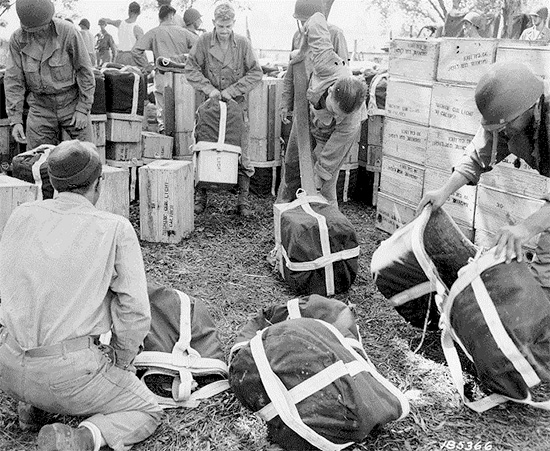
Second United States Army 1943 Tennessee Maneuvers. Quartermaster troops are packing .30 caliber ammo into aerial delivery containers for supply by air to troops participating in the Second US Army Tennessee Maneuvers. Photo taken at Camp Campbell, Hopkinsville, Kentucky, 9 June 1943.
Organization:
Initially constituted on basis of T/O 8-28 dated 1 April 1942 (as part of a Medical Regiment) with an authorized strength of 17 Officers and 184 Enlisted Men the Company was organized to provide temporary care and treatment of casualties, and to prepare them for evacuation with a minimum of personnel and equipment and without sacrificing mobility. It was understood that provisions were made for a possible expansion or cooperation with other medical units and installations. The Company’s first mission was to establish and operate the Clearing Station during combat, utilizing one or more Platoons (the Company had 3 Clearing Platoons –ed) depending on the prevailing tactical situation at that time. The Medical Clearing Company was essentially a mobile unit capable of operating with combat troops and had therefore neither the personnel nor the equipment necessary to provide definitive or prolonged treatment for serious cases (limited to treat surgical – medical – or gassed cases –ed).
The Clearing Station’s main function was triage. Accordingly incoming casualties were sorted and classified as follows:
- Patients requiring prolonged care and who were fit enough for immediate evacuation.
- Patients requiring prolonged care but who needed immediate treatment before evacuation was possible.
- Patients ready to be returned to duty within a few hours (number depending upon the necessity to keep the Clearing Station free and ready for movement –ed).
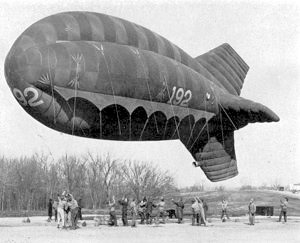
Camp Tyson, Paris, Tennessee. Personnel of a Barrage Balloon Battalion manhandle a balloon while on training. Camp Tyson was the only Barrage Balloon Training Center in the Zone of Interior. The 618th Medical Clearing Company staged at Camp Tyson in preparation for its movement overseas.
Assignments and Operations:
For the greater part of World War Two, the 618th Med Clr Co (Sep), operated under First United States Army. It was attached to the 134th Medical Group, one of the large medical organizations assigned to FUSA in the European Theater, but also operated under the 180th Medical Battalion in July-August-October-November-December 1944, and the 177th Medical Battalion in September 1944 and January 1945.
Background History
The 134th Medical Regiment was formed as a National Guard Unit in September 1940 by a cadre of personnel coming from the 102d Medical Regiment. During the period September 1940 – 27 January 1941, additional personnel were selected to bring the Regiment up to peacetime strength. At the time of Federalization, 27 January 1941, the 134th Medical Regiment consisted of Headquarters, a Service Company, and two Battalions each including 3 Ambulance Companies, 2 Clearing Companies, and 1 Collecting Company, all stationed and distributed over New York State.
The Regiment remained at its various locations in New York until 11 February 1941 when it received orders to move to Fort Bragg, Fayetteville, North Carolina (Field Artillery Replacement Training Center; acreage 129,422; troop capacity 4,311 Officers & 76,175 Enlisted Men –ed). On 1 May 1941 the Regiment was increased to wartime strength receiving 433 EM men from the Induction Center, Camp Upton, New York (Long Island, New York, Induction & Reception Center; acreage 6,736; troop capacity 331 Officers & 12,311 Enlisted Men –ed). Following implementation of the reorganization program of the US Armed Forces in 1942, the 134th Med Regt was reorganized in May of 1942 with its two Battalions now comprising 3 Collecting Companies and 1 Clearing Company each.
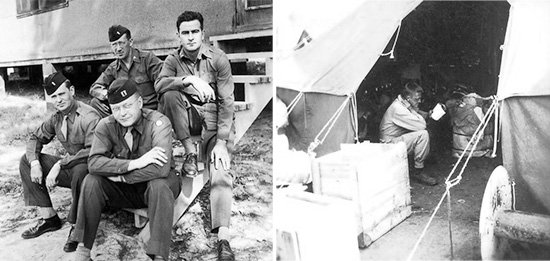
November 1943. Camp Tyson, Paris, Tennessee. 618th Medical Clearing Company Officers ready for the move to Camp Kilmer or Camp Shanks (Staging areas for New York POE).
Consistent with the new organization, the Regiment was reinforced with 1,100 recruits from several Reception Centers during October – November 1942.
The influx of additional personnel marked the beginning of the various phases of training which was hoped would lead to an eventual overseas assignment!
Change in Organization
The Regiment participated in the First United States Army North and South Carolina Maneuvers in 1941, the Second US Army Maneuvers in 1942 and once more in 1943. The 134th Medical Regiment, while on Second US Army Maneuvers in Tennessee (1943), was reorganized and redesignated the 134th Medical Group, 15 September 1943, at Shelbyville, Tennessee. Headquarters and Headquarters Detachment, 180th Medical Battalion, constituted 14 August 1943, were also activated 15 September 1943 during the Tennessee Maneuvers per Letter, Headquarters, Second United States Army, File No. AG 322.05 – 17 (GNMBF), dated 4 September 1943, as one of the two Battalion Headquarters attached to the 134th Medical Group (the other was the 179th Medical Battalion –ed). More than three months of training and practical application of medical service under simulated combat conditions were completed during the Tennessee Maneuvers.
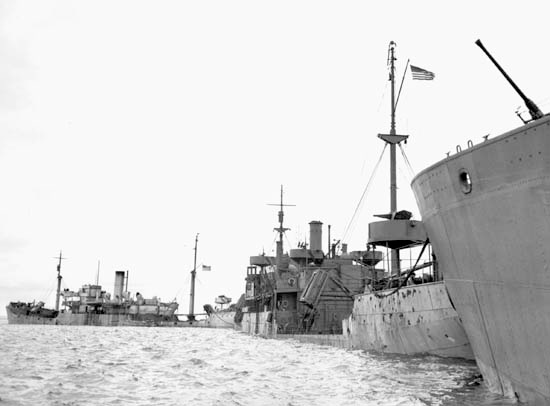
June 1944. Partial view of Gooseberry 1 breakwater off Utah Beach. Block ships (designated corn cobs) crossed the English Channel and were then scuttled in fixed positions to create sheltered water areas at the landing beaches. Once in position they formed Gooseberries. Gooseberry 1 off Utah Beach consisted of 10 such ships.This facility was most probably used by the 618th Medical Clearing Company when landing in Normandy.
On 19 November 1943, 134th Medical Group Headquarters and attached units were alerted for transfer to Camp Tyson, Tennessee, where they arrived on 1 December 1943. On 1 December 1943, Headquarters and Headquarters Detachment, 180th Medical Battalion were also ordered to move by motor convoy to the Concentration and Staging Area at Camp Tyson in Tennessee.
Preparation for Overseas Movement:
In January 1944 the newly organized 134th Medical Group was located at Camp Tyson, Paris, Tennessee (Barrage Balloon Training Center; acreage 7,014; troop capacity 772 Officers & 12,543 Enlisted Men –ed) preparing for movement overseas (POM). Units attached to the Group at the time included:
Headquarters and Headquarters Detachment, 179th Medical Battalion
Headquarters and Headquarters Detachment, 180th Medical Battalion
462d Medical Collecting Company
463d Medical Collecting Company
464th Medical Collecting Company
465th Medical Collecting Company
621st Medical Clearing Company
622d Medical Clearing Company
664th Medical Clearing Company
The following information is confusing. It seems that a number of alert and movement orders were fouled up, resulting in overseas movement of some units at different times and from different staging/embarkation areas. This caused a number of units to arrive at their respective overseas destination at different periods in time.
As per vintage reports, an advance party consisting of 6 Officers and 6 EM pertaining to the 134th Medical Group departed Camp Tyson, Paris, Tennessee on 16 December 1943 for one of the New York POE Staging Areas. This advance detachment left New York on 2 January 1944 and eventually reached England, via Glasgow with the mission to prepare for the arrival of the main body of troops by securing billets, drawing rations and locating and securing essential equipment for the Group. On 14 January 1944 Headquarters and Headquarters Detachment, 134th Medical Group and the following units entrained for Camp Kilmer, Stelton, New Jersey (Staging Area for New York Port of Embarkation; acreage 1,815; troop capacity 2,074 Officers & 35,386 Enlisted Men –ed):
Headquarters and Headquarters Detachment 179th Medical Battalion
Headquarters and Headquarters Detachment 180th Medical Battalion
463d Medical Collecting Company
464th Medical Collecting Company
466th Medical Collecting Company

July-August 1944. Different views of the 618th Medical Clearing Company while bivouacking in France …
The train reached Camp Kilmer 16 January early morning and upon arrival the men were immediately billeted and allowed to rest. Following inspections, physicals, and processing, twelve-hour passes were issued to 50% of the command. It was found out that 3 of the units (621st – 622d – 664th Med Clr Cies –ed) that departed Camp Tyson, Tennessee on 10 January for Camp Shanks, New York, were in fact no longer part of the 134th Medical Group having been shipped as separate units overseas.
On 7 February 1944 another advance party boarded the British passenger ship HMT “Andes” (built in 1939, and in lieu of a making her maiden trip as a passenger vessel, converted to a troopship at Belfast, N. Ireland –ed) and on 8 February 1944 the remainder of the detachment went aboard. The British passenger liner “Andes” sailed out of New York harbor on 9 February 1944 with Headquarters 134th Medical Group, Headquarters 179th Medical Battalion and many other troops aboard, amounting to a total of over 5,000 passengers (including 203d AAA (AW) Bn (SP), 635th TD Bn, 1195th Engr Cbt Gp, 39th Evac Hosp, and miscellaneous units –ed). The ship, traveling alone, was severely overcrowded; food served on board was prepared British-style and only two meals a day were served. The PX was open during most of the voyage and did much to afford extra comforts and snacks. Daily boat drill, blackout measures, exercising and conditioning, KP details, dispensary service, etc. were held and set up. The crossing of the Atlantic was without incident except for three days of rough seas. HMT “Andes” reached Liverpool, England, on 17 February 1944 with debarkation taking place the next day (upon arrival at the Port of Debarkation and until reaching its planned destination in the United Kingdom the 134th Medical Group Headquarters was without attached units, of which some had traveled on different dates and ships –ed).
United Kingdom:
Following debarkation at Liverpool, 134th Group Headquarters traveled by special train to Reading where they were welcomed by members of the advance party and then transported by truck to the unit’s station at Henley-on-Thames, Oxfordshire, England. Headquarters & Headquarters Detachment, 134th Medical Group arrived at Henley-on-Thames on 19 February. Upon arrival the Group was assigned to the First United States Army.
Following arrival in the UK Colonel Lee R. Wilhite, MC, O-195471, Commanding Officer, 134th Medical Group, reported to the Surgeon, First United States Army, and was given the general plan of operation and contemplated overall training for medical units pertaining to FUSA.
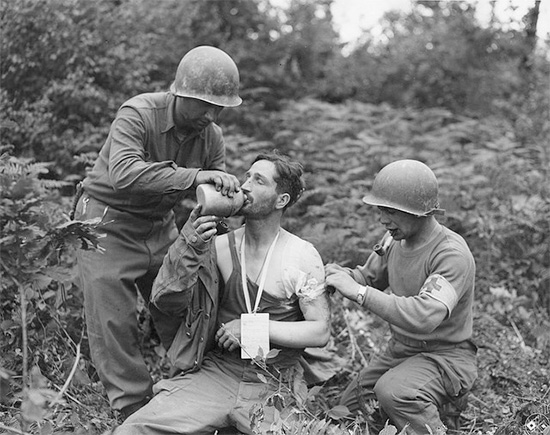
Casualty treatment in the field.
On 7 March 1944 in accordance with the Army Surgeon’s plan to establish “Special Purpose” Medical Groups for operations on the Continent the 134th Medical Group was reformed into a “Clearing Company” Group. In order to conform to the new policy, the following units were attached to the Group:
Headquarters and Headquarters Detachment 177th Medical Battalion
Headquarters and Headquarters Detachment 180th Medical Battalion
617th Medical Clearing Company
618th Medical Clearing Company
621st Medical Clearing Company
622d Medical Clearing Company
633d Medical Clearing Company
662d Medical Clearing Company
The training program instituted immediately after arrival in the United Kingdom by 134th Medical Group Headquarters was based primarily on individual Specialist training. Since all the attached units had undergone extensive periods of technical and tactical training in the Zone of Interior prior to embarkation for overseas, the plans focused on the treatment of the sick and wounded at the unit’s station as well as in the field. Procurement and release of organizational equipment was coordinated with Southern Base Section, United Kingdom, European Theater of Operations.
In April 1944, while still in the United Kingdom, the 622d Medical Clearing Company was designated a provisional Exhaustion Hospital for the treatment of severely disturbed N-P patients who would be supervised up to a period of 72 hours of treatment (the reason was to primarily avoid congestion at the Evacuation Hospitals and to make available a larger number of beds for surgical patients; moreover the idea was to treat such cases as possible near the front so as to return them as soon as possible to duty; separate treatment would also avoid infecting other patients with N-P symptoms –ed). Plans were made to expand and equip this Hospital to operate 2 Platoons with a 250-bed capacity each and the necessary requisitions to equip a 500-bed Exhaustion Center were subsequently approved by the CO, 134th Med Gp. A special ten-day training course was organized for personnel of the 622d Medical Clearing Company and for personnel of the Neuro-Psychiatric sections of nearby Evacuation Hospitals who were to augment the 622d Medical Clearing Company. The course started 25 April 1944 and was conducted by Major Harry G. Rainey and Major Phillip Wagner, Psychiatrists attached from the 128th Evacuation and 45th Evacuation Hospitals respectively.
Meanwhile, while awaiting further instructions, quotas for Officers to attend special courses in Neuro-Psychiatry, plaster technique, bomb disposal and waterproofing of vehicles were utilized, and techniques learned were relayed to other members of the command in scheduled separate lectures and classes. In the latter part of May 1944, great emphasis was placed on training in waterproofing of vehicles and in loading methods of vehicles in view of a forthcoming overseas movement. It was found that the loading of organizational equipment and as many personnel as possible on organizational transportation often caused a considerable overload of vehicles. However, the short period of overloading and distance to be traveled to the Marshalling Area resulted in no damage to the unit’s organic vehicles.
By end of May the 134th Med Gp CO, Colonel L. R. Wilhite, was summoned to First Army Headquarters for a final briefing. Alert Orders were received and final preparations were rushed to completion so that all units would be ready to go when movement orders were finally received.
France:
On 14 June 1944 the 621st Medical Clearing Company and the 622d Medical Clearing Company left for the Marshalling Area in Southern England. Colonel L. Wilhite accompanied these units so as to be able to coordinate their operation immediately upon arrival on the beach with First United States Army Headquarters and to plan for the arrival of later units.

Photos of individual Officers of the 618th Medical Clearing Company. Unfortunately their names are unknown.
The first units of the 134th Medical Group to arrive on the Continent were the 618th, 621st and 622d Medical Clearing Companies which landed in Normandy on 17 June 1944. The remainder of the units arrived separately during the next few days.
Other medical units having landed on Utah Beach on 17 June 1944:
67th Evacuation Hospital
Headquarters and Headquarters Detachment, 68th Medical Group
97th Evacuation Hospital
Headquarters and Headquarters Detachment, 175th Medical Battalion
Headquarters and Headquarters Detachment, 176th Medical Battalion
Headquarters and Headquarters Detachment, 178th Medical Battalion
427th Medical Collecting Company
502d Medical Collecting Company
576th Motor Ambulance Company
578th Motor Ambulance Company
Immediately upon arrival in Normandy, the 622d Medical Clearing Company proceeded to open two stations, one in Bernesq (approximately 7 miles south from Omaha Beach) operated by First Platoon and one at Ste-Mère-Eglise (approximately 9 miles from Utah beach, and about ½ mile south of this town) operated by Second Platoon. The Evacuation Hospitals which had been established earlier had kept on hand a large backlog of exhaustion cases which they immediately transferred to the 622d Medical Clearing Company, which had recently opened on 19 June 1944 and had been designated as one of the two First United States Army Exhaustion Centers. With noteworthy diligence and ingenuity, and assistance provided by Psychiatrist Officers on DS from some of the Evacuation Hospitals the Company met the situation and solved the problem satisfactorily (patients were sedated, received counseling, limited individual and group therapy, and took part in calisthenics and military drill, which was followed by a final examination and either return to duty or evacuation to the United Kingdom for further treatment –ed). However, the exhaustion casualty rate far exceeded advance estimates and it was soon obvious that it would be necessary to have at least two Clearing Companies performing this work and so the 618th Medical Clearing Company took over the station operating in Bernesq, allowing the 622d to concentrate on Ste-Mère-Eglise.
Headquarters Detachment, 134th Medical Group left on 18 June 1944 for their Marshalling Area in the United Kingdom. The trip was uneventful, and after a stay of only one day the unit embarked on an LCT for the Channel crossing. Due to the storms in the Channel the ship remained in harbor for three days, but then on 22 June 1944 the LCT set sail part of a large convoy bound for the coast of France. The Channel crossing was made without serious mishaps and the convoy arrived off Normandy on 23 June 1944. 134th Medical Group Headquarters landed on 23 June 1944 on Utah beach, and was met on site by the CO. After dewaterproofing the vehicles and reassembling at the designated area, the unit proceeded by motor convoy to a bivouac area at Ste-Mère-Eglise, Normandy, France.
The first phase of operations, beginning 23 June 1944 and lasting until 20 September 1944, of the 134th Medical Group on the Continent was to supervise and control all FUSA Clearing Stations, on Utah and Omaha Beaches, including the 2 Exhaustion Centers.
On 18 June 1944 the 621st Medical Clearing Company was ordered to establish an Air Holding Station just east of Ste-Mère-Eglise. For several days following, due to the storm in the Channel, sea evacuation could not be effected and all evacuation from the continent was made by air through this airstrip which continued operations until 2 July 1944.
As a result of the late arrival some units had been committed and attached to other Headquarters. The 618th Exhaustion Center was attached to the 180th Medical Battalion and Battalion Headquarters (which had landed on Utah Beach 10 July 1944 –ed) then moved on 12 July 1944 to Bernesq, France. Supply proved to be a major problem at this time since it was necessary as part of the psychological treatment of exhaustion cases to furnish patients with a complete new issue of clothing and equipment. The Battalion S-3 Department furnished orientation material for the Center’s rehabilitation program. While located at Bernesq, the 617th Medical Clearing Company and the 633d Medical Clearing Company were assigned to 180th Medical Battalion Headquarters. These units not only augmented Evacuation Hospitals but also assisted the 618th Exhaustion Center.
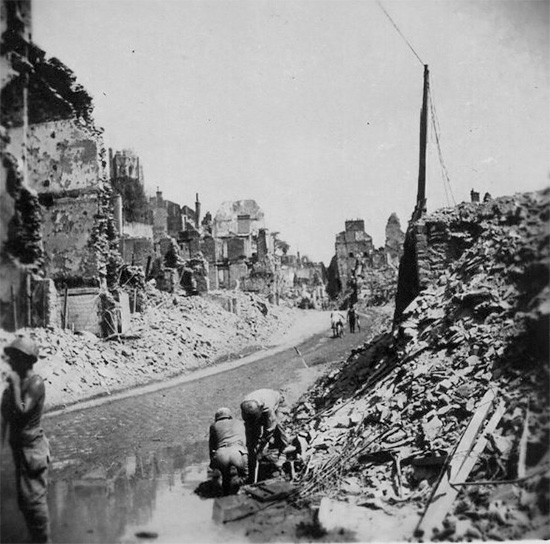
Summer of 1944. Ruins of St.-Lô, France.
During the extensive and bitter fighting early July 1944, preceding the St. Lô breakthrough (captured 18 July 1944 –ed), and especially immediately after the commitment of untried Divisions, the exhaustion rate reached extreme heights. At one time one station alone had over 1,200 patients. It was necessary at such times to augment the stations with Platoons from other Medical Clearing Companies. It had been planned to maintain as far as possible an Exhaustion Center on each flank of the First US Army. However, after the St Lô breakthrough, due to the long distances involved, the units’ rapid movement, and the problem of moving the bulky equipment of the expanded Clearing Companies, it was necessary to apply a general policy of leapfrogging. After closing the Falaise-Argentan gap in August 1944, the exhaustion casualty rate fortunately dropped, and it was only after the line stabilized near the Belgo-German border that an increase in patient census reoccurred.
180th Medical Battalion Headquarters, 617th Medical Clearing Company, 633rd Medical Clearing Company and the 618th Exhaustion Center departed Bernesq 5 August 1944, moving to Tessy-sur-Vire following the battle for St. Lô. Battalion Headquarters moved with units to a Medical Concentration Area established in the vicinity of Gathemo, France, on 18 August 1944, continuing later on to another Medical Concentration Area near Senonches.
Stations in France – 618th Medical Clearing Company
Utah Beach – 17 June 1944
Bernesq – 12 July 1944
Tessy-sur-Vire – 5 August 1944
Senonches – 24 August 1944
La Capelle – 4 September 1944
The handling of special cases during the Normandy Campaign and later on was taken care of by the 91st Medical Gas Treatment Battalion, which although primarily designed for the treatment of gas casualties (not used by the belligerents in the ETO during World War Two –ed), was utilized as a Hospital for the care of special types of cases, as they interfered with the primary mission of an Evacuation Hospital (the 91st Med Gas Tr Bn operated a provisional 1,020-bed Hospital while in Normandy –ed). After having been augmented with the necessary equipment, it was given the mission of handling a number of different cases such as:
- Contagious diseases > measles, mumps, chicken pox, scarlet fever, and dysentery
- Malaria > recurrent cases mainly contracted during operations in North Africa, Sicily and Italy
- Return to duty cases > following arrangements with G-1, First US Army, and the Replacement system, all cases returning to duty would be handled by the 91st Gas Treatment Battalion, the 4th Convalescent Hospital (which also operated a large Dental Clinic, while in Normandy –ed), and the 618th and 622d Medical Clearing Companies. This arrangement worked well during the earlier stages of the period, but as the movements of combat units became increasingly faster, it was difficult to organize at times, medical units were not relieved of their duty cases by the Replacement system.
- Self-inflicted Wounds > patients suspected of having wounded themselves to escape hazardous duty were transferred to this unit as soon as transportable. These cases were held pending investigation by a representative of the Inspector General Department
In some cases, both the 618th and 622d Medical Clearing Companies were engaged in handling return to duty cases, combat exhaustion cases, and neuro-psychiatric cases (it should be noted that following the speed at which combat forces moved forward this not only caused some changes in the policy of employment of Hospitals, but also in the utilization of the Medical Clearing Companies. Many Hospitals were needed in the forward zones while they were often still immobilized with a small number of non-transportable abdominal and chest cases. Hospitals were in need of a method to relieve them of such cases so that their efficiency would not be impaired by leaving groups of their own personnel behind to care for such non-transportable patients when moving forward to a new location. In view of this situation, the Army Surgeon instructed some of the Medical Clearing Companies to take over these cases, thus relieving the Hospitals of their responsibility. The Medical Clearing Companies became Holding Units caring for these patients until they were transportable and then evacuated them to ComZ Hospitals in the rear –ed).
The Companies were scattered at wide intervals over different beaches so that consolidated drawing of rations, gasoline and oil was not always feasible. While dumps of these items were quite numerous and easily accessible to all units, the greatest problem in supply concerned the equipping and maintenance of the two Exhaustion Centers. The tremendous overload each Exhaustion Center was forced to carry caused many supply problems. In this case and as proven throughout the entire campaign, the cooperation of Medical and Army Headquarters was on hand and they managed in the end to alleviate the deficiency in supply and allow the units to function without any further handicap.
Consequently the majority of combat exhaustion and neuro-psychiatric cases were, as before, evacuated to the 618th and 622d Clearing Companies. During the rapid advance through France another serious problem that arose was an acute shortage of gasoline, which nevertheless was gradually eliminated in time to prevent any loss of mobility.

Some statistics illustrating the numbers of Neuro-Psychiatric cases admitted and those returned to duty by the Exhaustion Centers for the period 6 June 1944 – 28 July 1944.
Belgium:
From 18 August 1944 to 19 September 1944, 180th Medical Battalion Headquarters had 2 Exhaustion Centers in operation (run by 618th Med Clr Co and 622d Med Clr Co), with the 617th, 621st, 633d and 662d Medical Clearing Companies attached and relieved from attachment at various times (depending on the tactical situation).
As of 10 September, the 546th and 575th Motor Ambulance Companies, the 464th Medical Collecting Company, and the 42d Field Hospital were attached to the Battalion, thereby considerably altering the unit’s mission.
On 14 September 1944 the 618th Medical Clearing Company in addition to receiving exhaustion patients, was designated a Transfer Point to which patients were sent from Hospitals for evacuation by Advance Section, Communication Zone (ADSEC, ComZ). Difficulties arose because of the constant movement of Hospitals, the tremendous distances involved, and the lack of adequate transportation. Because of this all available Hospitals had to be used as such, consequently the rate of incoming casualties far exceeded the handling capacity of the 618th Medical Clearing Company. This condition fortunately lasted but a few days and the 618th Med Clr Co subsequently resumed its mission as an Exhaustion Center.
Temporary Attachments – 618th Medical Clearing Company
180th Medical Battalion > 18 August 1944
177th Medical Battalion > 20 September 1944
On 7 September 1944 the 662d Medical Clearing Company was alerted for an undisclosed mission and on 17 September 1944 moved to Louvain, Belgium, under orders to report to the Commanding General British Headquarters for TD of approximately 3 days. Its mission proved to be in support of the TF operating in conjunction with the airborne landings in Holland (Operation “Market-Garden”). This Company never returned to Group control.
On 11 September it was learned that airstrip A-85 E at Senzeille (east of Cerfontaine, Belgium –ed), would become available to First US Army on 13 September (constructed by 820th Aviation Engineer Battalion, operational 9 September 1944 > 13 February 1945 –ed). ADSEC therefore placed an Air Holding Unit at that location. This was the first time since July that First Army had been afforded the opportunity to evacuate a significant number of casualties by air. However due to adverse weather conditions, variations in the number of planes available, and the increase in casualties as German resistance stiffened, the evacuation problem began again to assume critical proportions. At times, evacuation from the FUSA sector was closed down for periods ranging from twenty-four to forty-eight hours. Army Hospitals formerly held as reserves had to be pressed into service to provide holding capacity. A further temporary easing of this situation was effected by the arrival of Hospital Trains in Liège. However, an average of three trains daily would have been necessary to maintain complete evacuation of Army Hospitals but such numbers were not available. The 618th Medical Clearing Company, up to then primarily utilized for the hospitalization of combat exhaustion cases, was opened as a holding unit in the vicinity of Ouffet. It was necessary to use this unit in addition to those beds already set aside at Army Evacuation Hospitals to hold cases awaiting evacuation. On 18 September, a new airstrip, A-92 (designated B-62 by the RAF, constructed and maintained by the 834th and 862d Aviation Engineer Battalions, IX Engineer Command, operational from 18 September 1944 –ed), was opened in the vicinity of St. Trond, Belgium, and evacuation from it was instituted. The establishment of the 15th General Hospital in Liège came as a further aid to evacuation. However, a complete solution was not reached until mid-October. Many factors combined to bring about unsatisfactory conditions such as the lack of an administrative airfield, the inability to secure sufficient transport aircraft when a field became available, the inadequate numbers of General Hospital beds at reasonable distances from the Army area, the scarcity and irregularity in arrival of hospital trains, all combined to produce this situation. However, Advance Section, Communications Zone, continued to make strenuous efforts to improve this situation, and by mid-October amelioration, of all conditions mentioned above had been effected. At no time, despite this pressure, did any casualties suffer for lack of medical care.

Winter scenes in Belgium. Photos taken during the 618th Medical Clearing Company’s stay in Belgium.
On about 19 September 1944 the Army Surgeon determined that the most practical allocation of responsibilities was to charge each Group Headquarters with all evacuation within vertical sectors, divided normally along Corps boundaries. The 134th Medical Group lost all Clearing Companies except the 617th Medical Clearing Company, and in addition to retaining Headquarters 180th Medical Battalion, had attached to it the following units:
Headquarters and Headquarters Detachment 179th Medical Battalion
450th Medical Collecting Company
452d Medical Collecting Company
464th Medical Collecting Company
479th Motor Ambulance Company
546th Motor Ambulance Company
575th Motor Ambulance Company
583d Motor Ambulance Company
42d Field Hospital
47th Field Hospital
On 20 September, Battalion Headquarters and its attached units moved into area vicinity of Houffalize, Belgium. All units moved to Waimes, Belgium, 2 October.
On 20 September 1944, the 618th Medical Clearing Company was attached to the 117th Medical Battalion which also comprised the 427th and 493d Medical Collecting Companies, and the 622d and 633d Medical Clearing Companies. After mid-September Headquarters and Headquarters Detachments of the 57th and 177th Medical Battalions were placed directly under control of the Army Surgeon’s Office with the task to provide evacuation, reinforcement, and transportation to FUSA medical units concentrated in the vicinity of Eupen, Belgium. At the time, the 57th Medical Battalion was composed of Headquarters and Headquarters Detachment and the 384th and 591st Motor Ambulance Companies. The latter organization also ran the Provisional Truck Company.
Stations in Belgium – 618th Medical Clearing Company
Houffalize > 20 September 1944
Waimes > 2 October 1944
Ouffet > ? October 1944
Malmédy > 17 December 1944
(the Company was constantly on the move from 17 December 1944 until 31 December 1944 –ed)
Because the vehicles authorized by Tables of Equipment were never sufficient to move the expanded units shuttling and pooling of vehicles in the Group were the only means to move forward.
Battle of The Bulge:
On 16 December 1944 a report was received that the town of Malmédy was being shelled. This report came from the 44th and 67th Evacuation Hospitals functioning in that town. Report was also received that the city of Eupen was being hit. Two Hospitals, the 67th and 5th Evacuation Hospitals located in Malmédy and Eupen respectively, suffered a slight amount of damage to their buildings. The Commanding Officer and one NCO of the 454th Medical Collecting Company were killed during the shelling of Malmédy while rendering first aid to civilian casualties.

21 December 1944. Malmédy, Belgium. Some men belonging to the 618th Medical Clearing Company sit on a German Panther V tank disguised to look like an American M-10 Tank Destroyer. This armored vehicle was one those disabled at the papermill near the Warche River bridge (outskirts of Malmédy). The disguised tanks belonged to Otto Skorzeny’s Panzerbrigade 150 whose mission (Operation Greif) was to infiltrate American lines and spread confusion and consternation among troops withdrawing under the German counteroffensive.
At 1530 hours, 17 December 1944, orders were received at the 44th and 67th Evacuation Hospitals in Malmédy to evacuate their installations of all transportable patients and the bulk of their personnel. Later that night and during early hours of the following morning it became possible to complete the total evacuation of these two Hospitals. At 1900 hours, word was received that the enemy had made some penetration on the VIII Corps front and along the boundary between VII and V Corps. The Battle of the Bulge had begun with a major German Counter-Offensive in the region! Based on this information, the decision was made to move the First Hospitalization Unit of the 42d Field Hospital from Wiltz, and the 107th Evacuation Hospital from the vicinity of Clervaux, both in Luxembourg, to St. Hubert, Belgium, as fast as they could entruck; furthermore the 102d Evacuation Hospital was closed for admissions in preparation for further movement. Withdrawal of the Evacuation Hospitals was completed successfully but a portion of the 42d Field Hospital was overrun by the German advance. Lost with the Officers and EM of the Field Hospital was one Surgical Team belonging to the 3d Auxiliary Surgical Group.
All units of the 180th Medical Battalion, with the exception of First Platoon, 47th Field Hospital, left Waimes for Malmédy, Belgium on 17 December in the face of an enemy advance (also the 44th and 67th Evacuation Hospitals left with a Section of the 1st Medical Depot –ed). First Platoon, 47th Field Hospital was captured, 18 December, at Waimes, Belgium by enemy soldiers. The 180th Medical Battalion Commander, the Battalion S-3 and their driver, who had remained behind to evacuate the Hospital, were also taken prisoners. The unit was held for a brief period by the Germans but fortunately later liberated by an American armored reconnaissance unit. A series of rapid moves followed as the German salient expanded, presenting Battalion with difficult and variable problems of evacuation. On 17 December 1944, the unit moved from Malmédy to Spa, on 18 December it left Spa for Beaufays, from there it went to Huy and from Huy to Vierset-Barse, on 19 December the route went to Seilles, on 20 December the Battalion went back in the direction of Huy, on 24 December it was once more enroute to Spa, on 26 December Verviers was reached, and on 27 December 1944, the Battalion stopped and bivouacked in Wegnez (between Verviers and Pépinster, Belgium –ed). As of 31 December 1944, the following units were attached to the 180th Medical. Battalion; 423rd Medical Collecting Company, 464th Medical Collecting Company, 482nd Medical Collecting Company and the 575th Medical Ambulance Company.
In addition to the Hospitals in Malmédy, the 618th Medical Clearing Company operated a Combat Exhaustion Center in town. On 18 of December, such patients and personnel as could be moved were evacuated from this installation and a detachment consisting of 2 Officers and 18 Enlisted Men remained behind to take care of patients left in the station. On 20 December 1944, 247 patients and the remaining personnel of the 618th Medical Clearing Company were evacuated from Malmédy. During this period, constant check of the tactical situation was maintained in order to ascertain when it would be safe to attempt recovery of the equipment of the two Evacuation Hospitals abandoned in Malmédy and of Company “C” of the 91st Medical Gas Treatment Battalion similarly left behind in Grand-Halleux. On 19 – 20 December, after the northern advance of the German Forces had been checked south of Malmédy, the equipment of both these organizations was recovered!
On 18 December 1944, new orders were received from the Chief of Staff, First US Army, to evacuate all medical units then located in the town of Spa. Original plans called for evacuation to Remouchamps, but they were amended later and a new destination, the city of Huy, was indicated. On that day 1,000 patients were evacuated by ambulances and trucks from the 4th Convalescent Hospital, 900 going to the 3d Replacement Depot and 100 to the 130th General Hospital in Ciney. The 102d Evacuation Hospital entrucked and evacuated to Huy, closing there the evening of 18 December 1944. Later that night report was received that the 107th Evacuation Hospital in operation at St. Hubert, Belgium, and the 110th Evacuation Hospital at Esch, Luxembourg, were filled because evacuation was not keeping up with their admissions. ADSEC Surgeon’s Office was contacted and immediate relief of the situation effected.
On 19 December, because of the necessity for moving the 4th Convalescent Hospital (which first had to dispose of its 1,400 patients –ed), the bed capacity of Company “C” of the 91st Medical Gas Treatment Battalion was reduced to such levels that a 10-day evacuation policy could not be supported (FUSA was now conducting a total evacuation policy, as instituted on 19 December 1944 which would remain in effect until 12 January 1945 –ed.
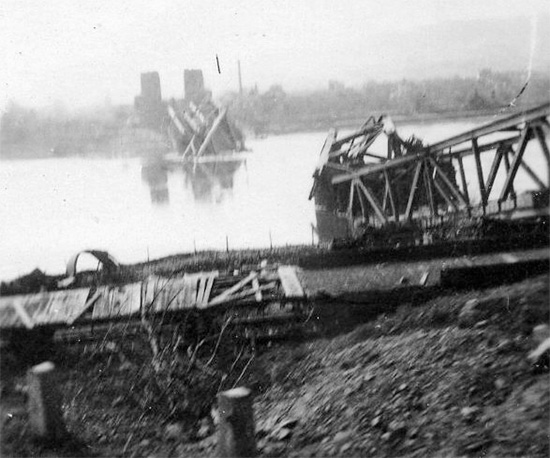
Partial view of the Ludendorfff Bridge at Remagen taken by a member of the 618th Medical Clearing Company. After being captured intact on 7 March 1945, the bridge finally collapsed due to structural damage on 17 March. The 618th Medical Clearing Company therefore had to cross the Rhine River on a pontoon bridge.
On 20 December a Letter of Instructions was received from G-4, First U. S. Army, informing that First US Army was to be placed under operational control of 21st Army Group. FUSA nevertheless wished to retain the following medical units in order to provide medical service for the Army units:
2d Evacuation Hospital
5th Evacuation Hospital
44th Evacuation Hospital
45th Evacuation Hospital
67th Evacuation Hospital
96th Evacuation Hospital
97th Evacuation Hospital
102d Evacuation Hospital
112th Evacuation Hospital
128th Evacuation Hospital
Headquarters & Headquarters Detachment, 68th Medical Group
Headquarters & Headquarters Detachment, 134th Medical Group
Headquarters & Headquarters Detachment, 50th Medical Battalion
Headquarters & Headquarters Detachment, 53d Medical Battalion
Headquarters & Headquarters Detachment, 57th Medical Battalion
Headquarters & Headquarters Detachment, 175th Medical Battalion
Headquarters & Headquarters Detachment, 176th Medical Battalion
Headquarters & Headquarters Detachment, 177th Medical Battalion
Headquarters & Headquarters Detachment, 179th Medical Battalion
Headquarters & Headquarters Detachment, 180th Medical Battalion
Headquarters & Headquarters Detachment, 187th Medical Battalion
382d Medical Collecting Company (Separate)
383d Medical Collecting Company (Separate)
423d Medical Collecting Company (Separate)
427th Medical Collecting Company (Separate)
439th Medical Collecting Company (Separate)
442d Medical Collecting Company (Separate)
445th Medical Collecting Company (Separate)
449th Medical Collecting Company (Separate)
450th Medical Collecting Company (Separate)
451st Medical Collecting Company (Separate)
452d Medical Collecting Company (Separate)
454th Medical Collecting Company (Separate)
457th Medical Collecting Company (Separate)
458th Medical Collecting Company (Separate)
459th Medical Collecting Company (Separate)
464th Medical Collecting Company (Separate)
468th Medical Collecting Company (Separate)
469th Medical Collecting Company (Separate)
470th Medical Collecting Company (Separate)
482d Medical Collecting Company (Separate)
484th Medical Collecting Company (Separate)
491st Medical Collecting Company (Separate)
492d Medical Collecting Company (Separate)
493d Medical Collecting Company (Separate)
479th Motor Ambulance Company
489th Motor Ambulance Company
546th Motor Ambulance Company
565th Motor Ambulance Company
575th Motor Ambulance Company
576th Motor Ambulance Company
577th Motor Ambulance Company
578th Motor Ambulance Company
583d Motor Ambulance Company
584th Motor Ambulance Company
956th Motor Ambulance Company
617th Medical Clearing Company (Separate)
618th Medical Clearing Company (Separate)
622d Medical Clearing Company (Separate)
628th Medical Clearing Company (Separate)
629th Medical Clearing Company (Separate)
633d Medical Clearing Company (Separate)
649th Medical Clearing Company (Separate)
660th Medical Clearing Company (Separate)
662d Medical Clearing Company (Separate)
684th Medical Clearing Company (Separate)
1st Medical Depot Company
Detachment “A”, 152d Station Hospital
13th Field Hospital
45th Field Hospital
47th Field Hospital
51st Field Hospital
66th Field Hospital
10th Medical Laboratory
3d Auxiliary Surgical Group
4th Convalescent Hospital
91st Medical Gas Treatment Battalion
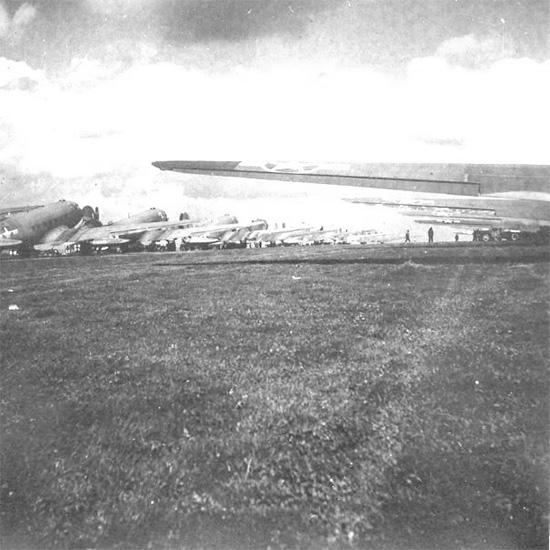
March-April 1945. Air evacuation taking place at the Y-71 Eudenbach airstrip, Germany. The 618th Medical Clearing Company evacuated a number of its patients through this airfield.
On 25 December 1944, G-4, First United States Army, instructed the Army Surgeon to move all medical units, other than those absolutely essential for operations, to a more secure position west of the Meuse River. It was further directed that any installation east of the Meuse be held in readiness for movement on twenty-four hours notice. Accordingly, the 96th, 5th, and 45th Evacuation Hospitals, the 4th Convalescent Hospital, plus Combat Exhaustion Hospitals and all Hospitalization Units of Field Hospitals not in use at the time, were directed to reconnoiter the specified area. Two (2) of the Evacuation Hospitals were ordered to find sites where it would be possible to receive patients. Many difficulties were encountered in finding suitable locations as the area contained few large towns. By 31 December, movement of medical units was completed. At this time First US Army, working under a total evacuation policy, had the following Evacuation Hospitals open; the 2d Evacuation in Eupen, the 128th Evacuation and 97th Evacuation Hospital in Verviers, the 102d Evacuation Hospital, and all three Hospitalization Units of the 51st Field Hospital in Huy. Plans were under way to replace the 51st Field Hospital with the 67th Evacuation Hospital at such time as its equipment was checked and ready. The 618th Combat Exhaustion Center opened at Avesnes, France.
Stations in France – 618th Medical Clearing Company
Avesnes > 31 December 1944
Stations in Belgium – 618th Medical Clearing Company
Antheit > 10 January 1945
Stations in Germany – 618th Medical Clearing Company
Rheinbach > 14 March 1945
Eudenbach > 28 March 1945 (Air Holding Unit at Y-71 airfield)
The beginning of January 1945 found the 2d Evacuation Hospital located in Eupen, the 97th and 128th Evacuation Hospitals in Verviers, the 102d Evacuation Hospital and the 51st Field Hospital in Huy.
However, it was the desire of the Army Surgeon to return as quickly as possible to a system whose facilities permitted holding, under Army control, the maximum number of cases whose hospitalization expectancy was of short duration. Accordingly, the 2d and 5th Evacuation Hospitals were ordered to receive cases of respiratory disease and cases with a hospitalization expectancy of ten days or less. The 2d and 5th Evacuation Hospitals returned convalescent cases to duty through the 91st Medical Gas Treatment Battalion. In addition, the 91st Med Gas Tr Bn still received cases of disease as before. Inability to open the 4th Convalescent Hospital necessitated this solution, which, though makeshift, served the desired ends. The system went into effect on 12 January 1945 and provided the basis for return to a 10-day evacuation policy.
In addition to the above installations, the 618th Medical Clearing Company now operated a Combat Exhaustion Center at Antheit in the vicinity of Huy. Later in the month, the 622d Medical Clearing Company was established at Eupen where it also functioned as a Combat Exhaustion Center.
Venereal disease cases were treated by a detachment from the 4th Convalescent Hospital operating at Company “B”, 91st Medical Gas Treatment Battalion. Thus, all functions formerly carried out by the 4th Convalescent Hospital were performed by other medical units, assisted in some cases by personnel from that organization.
During the month, the 622d Medical Clearing Company had established a Combat Exhaustion Hospital in the city of Eupen at the former site of the 45th Evacuation Hospital. Combat exhaustion casualties were at a low level during the entire period and at no time were either of the installations, the 618th or the 622d Medical Clearing Companies, overburdened.
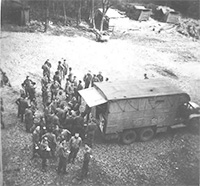 Clubmobile vehicle distributing coffee and snacks. |
 Vehicles pertaining to the Company’s motor pool. |
|
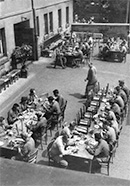 Company Headquarters personnel at dinner (Esterberg). |
 Enlisted Man having just removed the German flag from the Town Hall (Schleiz). |
 Sign indicating the Company’s Headquarters. |
On 3 January 1945, the Army Surgeon called a conference of the Commanding Officers of the 4th Convalescent Hospital, 91st Medical Gas Treatment Battalion, and the 177th Medical Battalion, the latter agency now being the administrative echelon governing above 2 Combat Exhaustion Centers. The purpose was to discuss the high rate of AWOL personnel charged to these units. An individual could rejoin his unit and be physically present there while charged against the Hospital as being AWOL. Such charge remained until information filtered through channels and corrected the error.
Germany:
Simultaneously with the drive of the First Army from the Erft River toward the Rhine, First Army medical units were moved to support the operation. On 1 March 1945, 6 Evacuation Hospitals were open in support of these troops. The 96th Evacuation Hospital was established at Eschweiler where it was joined on the third of the month by the 45th Evacuation Hospital. The 5th Evacuation Hospital remained open at Eupen, Belgium, until 6 March 1945 at which time it closed and moved to Zülpich, opening there on 10 March. The 44th and 102d Evacuation Hospitals were functioning at Brand and were joined by the 103d Evacuation Hospital which had moved into bivouac on 4 March. The 103d Evac then moved to Bergheim and opened there on 8 March. Inasmuch as the incidence of respiratory diseases had not subsided the 128th Evacuation Hospital remained open at Banneux, Belgium, while the 4th Convalescent Hospital remained open at Spa, also in Belgium. At the time of the Rhine River crossing at Remagen (7 March 1945 –ed), 6 Evacuation Hospitals were open in support of FUSA. The 5th, 44th, 67th, 102d, 103d, and 128th Evacuation Hospitals were mostly concentrated in the rear of the bridgehead. Because of the great distance between the Evacuation Hospitals and the Convalescent Hospital the latter installation was closed on 12 March and the 45th and 96th Evacuation Hospitals in Eschweiler were assigned to function temporarily as Convalescent Hospitals.
The 2d Evacuation Hospital had been closed from 12 March through the remainder of the month. Efforts to establish it in a suitable location in the vicinity of Cologne had met with no success. With the decline in casualties the demand for the establishment of a large installation of this type had lessened. However, good use had been made of the personnel, 13 MC Officers and 23 ANC Officers being placed on temporary duty in various other units. Late in the month the equipment and remaining personnel of the Hospital were moved to Zülpich where the Hospital went into bivouac.
The supervision and operation of overrun German military hospitals proved a major task during the month of March and the days that followed. On 15 March the 64th Medical Group was ordered to place a supervisory medical detail at an overrun German military hospital in Linz, Austria. By the end of the month approximately 50 German Hospitals were under US Army Medical Department supervision. The policy adopted was to rid the large hospitals of convalescent patients by sending them to PW establishments/enclosures and close the smaller hospitals by transporting their patients to the large institutions. Freshly-wounded Prisoners of War were also admitted to the installations which were maintained. This latter decision lightened the load placed on First Army medical installations.
The distances from the main concentration of First Army Evacuation Hospitals to the temporary convalescent setup at Eschweiler had again become too great, mainly because of the traffic congestion on the roads. Furthermore, the 45th and 96th Evacuation Hospitals were needed again in their primary role. On 14th March 1945, the 618th Medical Clearing Company located at Rheinbach was designated a Convalescent Hospital. On 17 March, Company “C,” 91st Medical Gas Treatment Battalion at Euskirchen was also designated as a Convalescent Hospital. During this period the 4th Convalescent Hospital was freeing itself of patients in preparation for a move. On 22 March it opened at Euskirchen, relieving Company “C,” 91st Medical Gas Treatment Battalion and the 618th Clearing Company from their temporary assignment.
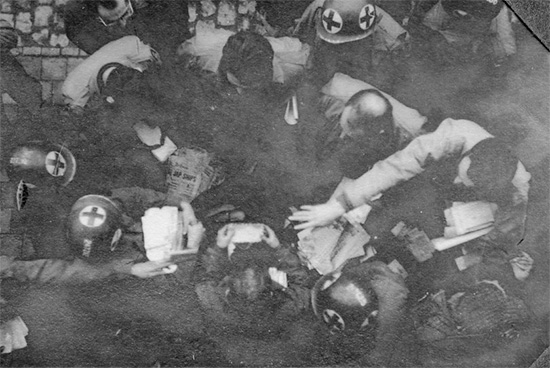
Typical view of Geneva Convention and individual Army Serial Numbers adorning the steel helmets of personnel belonging to the 618th Medical Clearing Company. Photo taken during mail call.
In support of the expansion of the bridgehead, FUSA Surgeon had the 45th Evacuation Hospital established at Honnef, opening there on 25 March; this unit was FUSA’s first Evacuation Hospital to set up across the Rhine River. The 5th and 44th Evacuation Hospitals also crossed the Rhine River and opened on 28 March 1945 at airstrip Y-71 near Eudenbach (constructed by the 925th Aviation Engineer Battalion, operational 25 March 1945 > 30 April 1945 –ed). The 128th Evacuation Hospital opened on the same date in the southern part of the Army sector at Ihrlich. Hospitalization in the First United States Army sector west of the Rhine was supplied by the 103d Evacuation Hospital at Bergheim, the 67th Evacuation Hospital at Bad Godesberg, and the 96th Evacuation Hospital at Dunstekoven. The 97th and 102d Evacuation Hospitals at Ahrweiler and Bad Neuenahr, respectively, were in position to receive casualties from both the western and eastern sides of the Rhine River.
As in the August 1944 breakthrough in France, the necessity and the opportunity arose of using the Field Hospitals as Evacuation Hospitals to keep pace with the rapidly moving combat troops. The 51st Field Hospital was assigned such a mission in the VII Corps Zone. On 30 March, its Second and Third Hospitalization Units were given this mission and established in the vicinity of Herborn, a centrally located area with a good road net. It is of interest to note that the Second Hospitalization Unit of the same Field Hospital was the first American Hospital across the Rhine, being established in Unker six days after the initial crossing. At the end of March 1945, Company “A”, 91st Medical Gas Treatment Battalion temporarily operated as an Air Holding Unit, opening at Gießen Y-84 airfield (constructed by the 816th Aviation Engineer Battalion, operational 30 March 1945 > 5 June 1945 –ed).
The close of March 1945 found the following numbered Hospitals in support of FUSA troops. The 5th and 44th Evacuation Hospitals were located at Eudenbach with the 67th Evacuation Hospital located at Herborn. The 45th Evacuation Hospital was moving to the vicinity of Marburg. The 103d, 97th and 102d Evacuation Hospitals were open on the west bank of the Rhine at Bergheim, Ahrweiler, and Bad Neuenahr with the 128th supporting the Army’s south flank at Ihrlich.
The capture of German PW camps presented another problem to FUSA authorities. Large installations of this type were uncovered at Diez, Lollar, and Wetzlar. Sanitary conditions at Diez were indescribable. A Clearing Company of the 134th Medical Group was placed in control and provisions for delousing and cleansing, serviceable sanitary facilities, medical care, and feeding were pushed to the utmost. Partially sufficient Allied medical personnel were at hand so that supervision by Medical Department personnel was all that was required. A Dispensary was placed in operation at all places named. Stringent measures for delousing were carried out to prevent the spread of typhus, and although scattered cases were uncovered in several localities, it was believed and later proven that adequate steps were taken to prevent its spread.
During the operation of closing the Ruhr pocket, many high ranking German medical officers had been captured, among them Major General Walter Scherf, the Surgeon of Armeegruppe “B.” A plan was devised therefore, for the eventual assumption of control of enemy sick and wounded, both military and civilian, by a German medical staff headed by Major General Scherf. He was established in a central headquarters in Weimar. The Army area was divided into two sectors, eastern and western, and a German sub-headquarters placed in each of these divisions. Security restrictions were imposed so that no member of this German Staff could move unless they were accompanied by United States Army personnel. American, German speaking, medical liaison Officers were attached to the central staff as well as to both subdivisions. United States Medical Department Enlisted personnel were to be placed at all German Hospitals to serve there as liaison personnel, accompanying the German medical staff on their rounds. At the end of the month of April, further plans were under way to procure the necessary vehicles and additional personnel to render this German medical service operational. Meanwhile FUSA Medical Groups continued their direct supervision of German medical installations. At the end of the month, augmented by the personnel of the 115th, 118th, 126th, and 134th Evacuation Hospitals, these groups were controlling 216 German Hospitals, rendering medical service to 4 PW camps, supervising the dispensary service at 22 DP centers and collecting points, and operating 3 Hospitals established for the care of RAMPs (Recovered Allied Military Personnel –ed). The total German and Allied patients hospitalized under supervision of the First United States Army medical service was estimated at 90,000 people.
Battle Credits – 618th Medical Clearing Company (Separate)
Bulge (Ardennes-Alsace) WD GO # 114 dtd 7 Dec 45
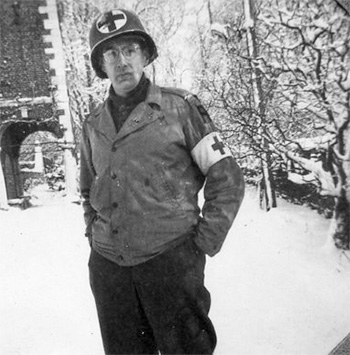
Winter 1944-1945. Photo illustrating Captain Philip Berwick, MC, O-484474, 618th Medical Clearing Company.
Return to the ZI:
The 618th Medical Clearing Company (Separate) finally left the European Continent, sailing from Le Havre, France, after staging at “Camp Lucky Strike”, one of the numerous Cigarette Camps in the area of Le Havre, and a Staging Area for either incoming troops or units returning to the Zone of Interior for inactivation, or for redeployment to the Pacific Area.
PASSENGER LIST
| Vessel: “Caribia” | Sailed from: Le Havre, France | Staged at: Camp “Lucky Strike” |
| Unit Shipment No. 10077 G | Unit Designation: 618th Med Clr Co (Sep) | |
| Name | Rank | ASR | ASN | Arm / Service | MOS | |
| ROOS, ALFRED T | (21) | Maj | 79 | 0-487653 | MC | Co Cmdr |
| BARBIERI, JOSEPH | (1) | Capt | 71 | 0-500902 | MC | D-3130 |
| BERWICK, PHILIP | (2) | Capt | 70 | 0-484474 | MC | D-3139 |
| BIGELOW, ARTHUR | (8) | Capt | 62 | 0-249332 | Ch C-Prot | 5310 |
| DONOVAN, JOHN T. Jr | (2) | Capt | 40 | 0-507570 | MC | 3100 |
| KIRKLEY, GEORGE C Jr | (15) | Capt | 79 | 0-1735421 | DC | 3170 |
| LOCHMAN, DAVID J | (16) | Capt | 75 | 0-419264 | MC | 3100 |
| MILLER, ALFRED B | (3) | Capt | 71 | 0-1695811 | MC | 3139 |
| NELSON, FRANK A | (7) | Capt | 73 | 0-498130 | DC | 3170 |
| WINTER, DONALD K | (6) | Capt | 66 | 0-435560 | MC | 3100 |
| CHAVIS, DEVNIE Jr | (20) | 1st Lt | 108 | 0-451312 | MAC | 2120 |
| GAUNT, ROBERT L | (3) | 1st Lt | 93 | 0-1542854 | MAC | 4113 |
| FLOM, ANDREW M | (7) | 2d Lt | 92 | 0-2015852 | MAC | 2120 |
| DYER, RALPH D | (20) | 1/Sgt | 66 | 39291128 | MD | 585 |
| BEESLEY, ROBERT A | (20) | S/Sgt | 78 | 39567846 | MD | 821 |
| GREEN, EDWARD A | (20) | S/Sgt | 78 | 39567812 | MD | 824 |
| MAHAFFEY, ARTHUR R | S/Sgt | 75 | 35383678 | MD | 14 | |
| MURPHY, PAUL H | (6) | S/Sgt | 75 | 35310442 | MD | 673 |
| SEIPLE FRED L | (6) | S/Sgt | 74 | 35018320 | MD | 673 |
| CICHIRILLO, JOHN | (20) | Sgt | 66 | 39568228 | MD | 673 |
| SORENSON, ROBERT E | (13) | Sgt | 69 | 39196192 | MD | 673 |
| WACH, CHARLES G | (7) | Sgt | 80 | 16069118 | MD | 60 |
| BAKER, JAMES L | (9) | Tec 4 | 77 | 37187871 | MD | 60 |
| BOHLMAN, ROBERT T | (16) | Tec 4 | 65 | 39617214 | MD | 60 |
| BRAFFORD, KOEWLER C | (6) | Tec 4 | 74 | 35472331 | MD | 14 |
| ENGEL, NEAL P | (16) | Tec 4 | 63 | 36251747 | MD | 861 |
| SOUTHARD, WOODROW H | (16) | Tec 4 | 77 | 37285563 | MD | 409 |
| STOVALL, JOSEPH T | (18) | Tec 4 | 77 | 38178049 | MD | 60 |
| THOMAS, WARREN H | (6) | Tec 4 | 74 | 35472469 | MD | 861 |
| THORNBURY, KENNITH F | (10) | Tec 4 | 57 | 39557029 | MD | 861 |
| VARDY, JAMED D | (10) | Tec 4 | 78 | 38105988 | MD | 149 |
| VOGT, MILTON L | (6) | Tec 4 | 61 | 35496830 | MD | 861 |
| LAWHON, EDWARD A | (7) | Cpl | 69 | 36569206 | MD | 409 |
| MENNINGER, STURAT E | (6) | Cpl | 74 | 35471615 | MD | 405 |
| PUTNAM, CLYDE A Jr | (20) | Cpl | 70 | 39276643 | MD | 405 |
| RUMPF, THOMAS A | (16) | Cpl | 77 | 36505690 | MD | 405 |
| SCARBOROUGH, ROBERT C | (6) | Cpl | 74 | 35472343 | MD | 673 |
| BRANHAM, JOSEPH | (6) | Tec 5 | 74 | 35440816 | MD | 405 |
| BROKAMP, WILLIAM J | (6) | Tec 5 | 74 | 35472317 | MD | 861 |
| BURRIS, DON H | (9) | Tec 5 | 78 | 37184958 | MD | 60 |
| CAULEY, MARVIN E | (9) | Tec 5 | 69 | 37601921 | MD | 14 |
| DAVIS, ALBERT | (19) | Tec 5 | 50 | 34788066 | MD | 60 |
| EATON, JOHN A | (2) | Tec 5 | 47 | 32666528 | MD | 861 |
| FENMEN, JOSEPH F | (21) | Tec 5 | 47 | 33340845 | MD | 861 |
| FRANCESCHI, FRANK J | (3) | Tec 5 | 69 | 33525518 | MD | 56 |
| GIANNAKIS, FERG E | (3) | Tec 5 | 74 | 35443593 | MD | 861 |
| GREER, JOHN W | (15) | Tec 5 | 70 | 34700858 | MD | 149 |
| GROTZ, ROBERT C | (6) | Tec 5 | 51 | 15301247 | MD | 858 |
| HESTER, THOMAS A | (6) | Tec 5 | 74 | 15117821 | MD | 861 |
| JOHNSON, JOHN B | (15) | Tec 5 | 62 | 34441371 | MD | 861 |
| McCOWEN, HOWELL H Jr | (6) | Tec 5 | 74 | 35507363 | MD | 409 |
| MCDONALD, NORMAN E | (12) | Tec 5 | 77 | 39026966 | MD | 855 |
| RANKIN, ROLAND G | (6) | Tec 5 | 74 | 15117798 | MD | 409 |
| ROBINSON, ALLEN E | (13) | Tec 5 | 66 | 39205544 | MD | 345 |
| SCHWEMMLER, BERNARD M | (16) | Tec 5 | 75 | 37298395 | MD | 345 |
| SETSER, CLEETIS | (6) | Tec 5 | 72 | 35638675 | MD | 861 |
| STINSON, ALLEN A | (6) | Tec 5 | 74 | 35472471 | MD | 345 |
| TRAFFORD, GEORGE W | (16) | Tec 5 | 75 | 37299100 | MD | 55 |
| VANKIRK, ALVIA S | (6) | Tec 5 | 74 | 15117824 | MD | 861 |
| WESTLING, ROY E | (16) | Tec 5 | 75 | 37298549 | MD | 855 |
| WETZEL, BENNY A | (3) | Tec 5 | 70 | 33550874 | MD | 345 |
| WYATT, EUGENE L | (9) | Tec 5 | 69 | 37602927 | MD | 60 |
| AASLAND, ARTHUR C | (16) | Pfc | 75 | 37298516 | MD | 657 |
| BATES, THURMAN | (14) | Pfc | 77 | 38153594 | MD | 196 |
| BERNE, TONY J | (21) | Pfc | 72 | 33682761 | MD | 345 |
| BOWERS, WILFORD R | (20) | Pfc | 78 | 37328741 | MD | 657 |
| BROWNLEE, ROY | (16) | Pfc | 40 | 37116342 | MD | 409 |
| BURCHARDT, FELIX | (7) | Pfc | 78 | 36241758 | MD | 657 |
| CARPENTER, EDWARD R | (1) | Pfc | 69 | 31316676 | MD | 409 |
| CLOUGH, RAYMOND | (1) | Pfc | 69 | 31267047 | MD | 345 |
| COOKE, EDWARD M | (11) | Pfc | 74 | 35443465 | MD | 657 |
| DONIS, ROBERT V | (14) | Pfc | 66 | 39413323 | MD | 345 |
| DONLEY, JOHN R | (6) | Pfc | 71 | 35421176 | MD | 861 |
| FISHER, DENVER | (3) | Pfc | 74 | 35443442 | MD | 345 |
| GRIMES, TRUMAN L | (3) | Pfc | 69 | 33556899 | MD | 590 |
| HENNESSEY, GEORGE E | (3) | Pfc | 74 | 33373824 | MD | 409 |
| HIGNITE, JAMES H | (7) | Pfc | 25 | 36890915 | MD | 657 |
| JOHNSON, CLAYTON H | (6) | Pfc | 75 | 35440804 | MD | 861 |
| MARCUM, JAMES | (6) | Pfc | 75 | 35444591 | MD | 657 |
| MARTIN, AMOS | (6) | Pfc | 72 | 35638453 | MD | 656 |
| MARTIN, DONALD E | (6) | Pfc | 74 | 35443699 | MD | 657 |
| MARTIN, RALPH L | (6) | Pfc | 75 | 35471320 | MD | 657 |
| MARTIN, ROSS W | (6) | Pfc | 75 | 35467807 | MD | 409 |
| McILVAIN, EDWARD T | (6) | Pfc | 74 | 35471025 | MD | 409 |
| McMINN, THOMAS J | (1) | Pfc | 71 | 31331747 | MD | 657 |
| NOLAN, LAWRENCE V | (2) | Pfc | 69 | 32804194 | MD | 409 |
| NORDVALL, GUSTAV M | (16) | Pfc | 75 | 37298535 | MD | 196 |
| ODABASHION, GEORGE | (21) | Pfc | 69 | 33584493 | MD | 657 |
| PETTIT, CARL W | (3) | Pfc | 75 | 35443012 | MD | 409 |
| PHILLIPS, HARRY V | (6) | Pfc | 72 | 35670279 | MD | 590 |
| PHILLIPS, MACK E | (6) | Pfc | 74 | 35474009 | MD | 409 |
| PIERCE, WINFORD D | (6) | Pfc | 75 | 35471953 | MD | 657 |
| POPOVICH, MICHAEL Jr | (4) | Pfc | 70 | 33420841 | MD | 861 |
| RAPP, GEORGE C | (6) | Pfc | 74 | 15117823 | MD | 345 |
| RAULSTEN, QUENTIN W | (9) | Pfc | 70 | 37496378 | MD | 657 |
| RUBLE, CARL M | (3) | Pfc | 74 | 35442909 | MD | 657 |
| SHILLINGSTAD, HAROLD A | (16) | Pfc | 75 | 37299095 | MD | 657 |
| SENDEK, BERNARD J | (21) | Pfc | 70 | 33571527 | MD | 345 |
| SMITH, HIGGINS | (6) | Pfc | 72 | 35638391 | MD | 657 |
| SODERBERG, NORMAN A | (16) | Pfc | 75 | 37298346 | MD | 861 |
| SPENCE, ELZA M | (6) | Pfc | 72 | 35670138 | MD | 861 |
| SPRADLIN, HERBERT | (6) | Pfc | 72 | 35638402 | MD | 196 |
| WARD, BILLIE | (7) | Pfc | 73 | 35444578 | MD | 861 |
| ANTHONY, MARVIN L | (11) | Pvt | 70 | 34601438 | MD | 657 |
| COVERT, GERALD L | (9) | Pvt | 53 | 37441270 | MD | 657 |
| DEGRAFFT, RALPH E | (1) | Pvt | 50 | 31428747 | MD | 657 |
| FICKLIN, LEA R | (18) | Pvt | 50 | 38154536 | MD | 657 |
| HAMMAS, WILLIAM E | (2) | Pvt | 75 | 37298345 | MD | 657 |
| HUDSON, HARRY H | (16) | Pvt | 75 | 37298544 | MD | 657 |
| MANNING, ROBERT P | (6) | Pvt | 79 | 35264555 | MD | 657 |
| MANNINO, FRANK | (1) | Pvt | 62 | 32986182 | MD | 657 |
| McGHEE, DAVID R | (3) | Pvt | 56 | 33657171 | MD | 657 |
| PENTZEL, JAMES E | (2) | Pvt | 68 | 32814216 | MD | 657 |
| SIRONI, CHARLES | (1) | Pvt | 79 | 31254795 | MD | 657 |
| STROUD, WILLIAM A | (6) | Pvt | 69 | 35696867 | MD | 657 |
The SS “Caribia” arrived in New York POE on 14 August 1945. Following debarkation, the members of the organization received their final orders before being transferred to the respective Separation Centers for Discharge.
Our special thanks go to Bob Berwick, son of Major Philip Berwick (O-484474) a Physician who served with the 618th Medical Clearing Company in the European Theater of Operations. Bob provided us with a large number of pictures taken by his Father which helped us illustrate this concise Unit History. Our sincere appreciation for Bob’s generous assistance. We are still looking for more information relating to the unit’s last days spent in the European Theater and its eventual return to the Zone of Interior. A Personnel Roster would also be welcome. Thank you.
